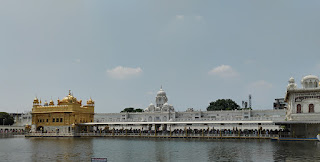After an overnight stop in Delhi, we boarded a train and headed up to Amritsar. We had a brief walk around when we got there, mainly just to stretch our legs having been on the train for over 6 hours.
Our hotel was quite close to the main sites, so we could walk to everything. The next day we went to the main site that I wanted to see, the Golden temple (Sri Harmandir Sahib). It was completed in 1589 and is the holiest site in Sikhism. It has been destroyed and rebuilt a number of times, the last time in marble and cooper then overlaid with gold leaf in 1830, hence the name.
I didn't go into the shrine as there were literally thousands of people queuing. According to Wikipedia, over 150,000 people visit the shrine EVERY DAY.
Instead, I walked around the complex which is a collection of buildings around the sanctum and the pool. These include a clock tower, the offices of the Gurdwara Committee, a Museum and a langar – a free Sikh community-run kitchen that offers a vegetarian meal to all visitors irrespective of their beliefs.
Later that day we visited Jallianwala Bagh a monument and museum. It was here that hundreds of innocent people were massacred during a peaceful protest on 13th April 1919 when General Dyer ordered his troops to open fire. Another bloody page in the British history of conquest
The Partition Museum was very interesting and documents the history leading up to partition and the riots that followed the division of British India into two independent dominions: India and Pakistan.
From Amritsar we boarded a train to Chandigarh then took a bus to Shimla. It was a long 12 hour travelling day as we couldn't book the Himalayan Queen train. The city is the terminus of the narrow-gauge Kalka-Shimla Railway which was completed in 1903. At 2,200m above sea level, Shimla is in the Himalayan foothills and was once the summer capital of British India.
As you can imagine, the city is spread out and built into the very steep hills so it wasn't easy to get around. Here is the view from our hotel room.
Mall Road is one of the main areas to head for and is the centre for shops and restaurants. There is a lift that takes you to the top as no traffic is allowed. From here we walked up to Christ Church and the view from The Ridge. Unfortunately, it was all clouded in so we didn't get the views we had hoped for.
That afternoon, up in the clouds, we visited the Rashtrapati Niwas (the President's Residence) formerly known as Viceregal Lodge. It was formerly the residence of the British Viceroy of India.
At least the weather was much cooler and we walked back to our hotel down the winding roads and in the rain
The next day we visited the Railway museum thinking there would be a lot of information on how the narrow guage railway was built. Instead it had a few heritage pieces from the various stations and nothing about the actual construction of the 98 kilometres of track or the 103 tunnels of which 102 are still in use.
Then it was back on the bus for the long 10 hour journey down to Delhi and our last week in India

















No comments:
Post a Comment